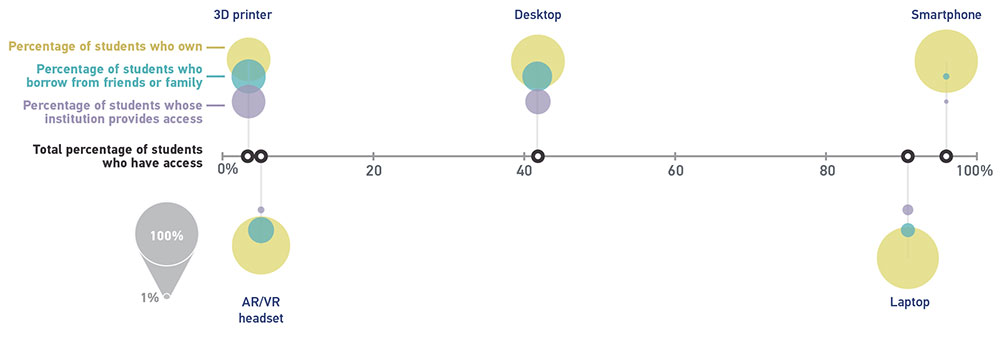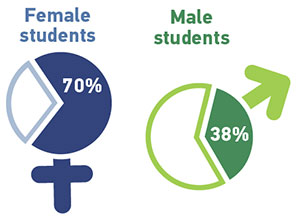Device Access, Ownership, and Importance
Our finding that more community college students work and take care of families may also help us understand what they told us about the devices they use for their academics. As noted in EDUCAUSE's 2018 student study, we improved our inquiry process regarding student device ownership to be more in line with principles of equitable access. To avoid socioeconomic bias, we asked first if students had access to a variety of technologies, and then asked how they access those devices (personally owned, borrowed from friends/family, or provided by their campus). Although the percentages of community college and non–community college students who said they own smartphones and laptops are identical, or nearly so (nearly all own),1 our results indicate some differences in ownership of other technologies. Of those community college students who have access to desktop computers (42%, compared with 34% among non–community college students), more reported owning these devices (73%) compared with their peers at four-year colleges and universities (60%).
The vast majority of students in both groups (over 90%) said laptops are very or extremely important for their coursework; however, slightly fewer community college respondents (85% versus 91%) reported using laptops for all or most of their courses. This slight difference could be attributed to several factors. Not surprisingly, nearly all (97%) two-year and AA students live off campus, so they may use a desktop computer that already exists in their household, in addition to using a personal laptop.2 Students in the STEM fields, particularly those in computer and information sciences, reported higher percentages of desktop ownership than did other majors, which may suggest these students either want or require devices with more computing power (e.g., for personal gaming, specialty software for coursework, or more storage to meet their household's needs). And having access to those devices at home may be convenient or even necessary due to work schedules and family responsibilities.
Our results indicate that the number of students who have access to newer technologies, specifically AR/VR headsets and 3D printers, is very small and essentially the same for community college and four-year students (figure 3). A mere 5% of community college students and 4% of their four-year peers reported having access to AR/VR headsets, and only 3% in each group said they had access to 3D printers. However, community college students in our sample access these technologies in different ways. Of the few two-year and AA students who have access, the majority (84%, compared with 71% among non–community college students with access) personally own AR/VR headsets,3 while only 2% said these devices were provided by or on loan from their college (compared with 9% among students at other institutions). The majority of the community college students who own AR/VR headsets also own gaming systems, so students may be using these technologies together for entertainment purposes. Access to 3D printers via personal ownership was also higher for community college students (47%) compared with students at other types of institutions (27%). This was a surprising finding, given that community college students tend to be economically disadvantaged compared to their peers at four-year colleges,4 and 3D printers can be expensive. Our data suggest that 3D printers are not as accessible on the community college campuses in this sample as at other types of institutions; fewer than a third of community college students with access to 3D printers (28%) said they were provided by their school, while the majority (60%) of their four-year counterparts reported they accessed these at their institution. Generally, there were no significant differences in access to either AR/VR or 3D printers by ethnicity between community college students or among four-year students, but we did observe that significantly more nonwhite than white students reported owning 3D printers in both groups.

Although fewer students at community colleges reported that their campus provided AR/VR headsets and 3D printers, these devices appear to be having an impact on students. More community college students rated AR/VR headsets (30% among students who use them for academic work) as very or extremely important to their academic success than did students at other schools (23%). And 3D printers seem to be even more valuable to community college students, with 55% of those who use them for academic work rating them very or extremely important, compared with 41% among students at other institutions. The percentages of community college and non–community college students who reported using mainstream technologies (e.g., laptops, desktops, hybrids, tablets, smartphones) for most or all of their courses were the same or similar; however, community college students who use 3D printers for academic work more often reported using them in most or all of their courses (24%, compared with 12% among students at four-year institutions).
The growth of certificate and degree programs in the area of additive manufacturing, where coursework focuses on 3D digital design and manufacturing technologies,5 is one possible explanation for the high value placed on 3D printing at two-year and AA institutions. In an effort to address an increasing skills gap in the manufacturing workforce, initiatives such as America Makes, "Creating Connections in Manufacturing Communities with Community Colleges," and the "Community College Advanced Manufacturing Career Pathways" are supporting industry and community college partnerships to train future employees; as a result, more community colleges are making 3D printing the centerpiece of design courses.6
The fields and disciplines students at community colleges are majoring in may shed some light on the differences in their use of and regard for 3D printing technologies. A plurality (28%) of the two-year and AA students in this study are majoring in health sciences, including professional programs; this is significantly more than students at other institution types (16%). Eighty-four percent of 3D printer users studying health sciences rated them as very or extremely important to their academic success, which suggests health science programs may be incorporating this technology into their curricula, or students are seeking out 3D printers as a supplement to their instruction. IT professionals at community colleges are recognizing the importance of these bleeding-edge devices as well. In a 2018 EDUCAUSE survey on extended reality (XR) technologies, most respondents at AA institutions rated the potential value of augmented reality (AR) and virtual reality (VR) technology as high (86% and 87%, respectively) in the fields of medicine and health.
Making this technology more accessible on community college campuses could help prepare students for positions and careers in health care, where labor shortages are being reported.7 The demand for professionals in allied health care (e.g., medical assistants, occupational therapists, pharmacy technicians, dental hygienists, surgical technologists, laboratory technicians) is also expected to impact rural parts of the United States substantially.8 Research has shown that community colleges play a critical part in educating and training residents and workers in nonurban areas in the health sciences. For example, a Rural Health Research Center study found that the majority of individuals who finished allied health programs for occupations that are most commonly available in rural areas did their coursework at community colleges.9 Another study revealed that 75% of registered nurses working in rural areas obtained their foundational training in associate degree and/or certification programs.10
Females, 3D Printers, and Majors
Almost twice as many female as male community college students said 3D printers were very or extremely important to their academic success. Women who rated 3D printers highly were more likely to be health sciences, including professional programs, and engineering and architecture majors.

Regardless of geography, though, two-year and AA schools are providing opportunities for health science students to build skills that can translate to immediate and local employment, and these advanced technologies can aid in their preparation. Some community colleges are already leveraging the power of these technologies, from using VR programs to develop their clinical and empathy skills11 to 3D printing assistive devices for individuals with disabilities.12 Using VR for patient simulations is especially useful in helping students strengthen their skills, as it allows for the repetition of hands-on experiences (such as practicing in emergency medical situations or diagnosing rare conditions).13 With this is mind, providing greater access to 3D printers and other next-gen tech such as AR/VR headsets can help future practitioners train in safe environments with simulated tools and equipment.14 Specific recommendations for deploying a campus 3D technology initiative are outlined in the 2018 Learning in Three Dimensions: Report on the EDUCAUSE/HP Campus of the Future Project. Allocating money, staff, and time to its development and implementation is the first step.
Notes
-
Ninety-five percent of respondents have access to a smartphone (of whom 99% own them personally), and 91% have access to a laptop (of whom 97% own them personally).
↩︎ -
Nearly all respondents reported owning at least two internet-capable devices.
↩︎ -
Examples of AR/VR headsets provided in the survey ranged from the low to high end, and included Google Cardboard/Daydream, Google Glass, Oculus Rift, and Samsung Gear VR.
↩︎ -
"Bridging the Higher Education Divide: Strengthening Community Colleges and Restoring the American Dream," Century Foundation, New York, 2013.
↩︎ -
"3D Digital Design and Manufacturing Technology," Engineering Technology, Cuyahoga Community College; Lauren Mandery, "Additive Manufacturing Education Is Helping to Bridge the Workforce Development Gap," Stratasys, June 18, 2018.
↩︎ -
"Additive Manufacturing Can Provide Prototype of Skill Set Required to Be Competitive in Growing Job Market," California Community Colleges, Programs to Watch.
↩︎ -
Parija Kavilanz, "The US Can't Keep Up with Demand for Health Aides, Nurses and Doctors," CNN Business, May 4, 2018; Marisa Lifschutz, "Top Five Sectors Exposed to Labor Shortages in 2018," Ibis World, Industry Insider, July 12, 2018.
↩︎ -
Elizabeth Burrows, Ryung Suh, and Danielle Hamann, "Health Care Workforce Distribution and Shortage Issues in Rural America," National Rural Health Association Policy Brief, January 2012.
↩︎ -
S. M. Skillman, G. A. Keppel, D. G. Patterson, and M. P. Doescher, "The Contributions of Community Colleges to the Education of Allied Health Professionals in Rural Areas of the United States," WWAMI Rural Health Research Center, October 2012.
↩︎ -
Roxanne Fulcher and Christopher M. Mullin, "A Data-Driven Examination of the Impact of Associate and Bachelor's Degree Programs on the Nation's Nursing Workforce," American Association of Community Colleges, Policy Brief 2011–02PBL, March 2011.
↩︎ -
"Foundation Funds Virtual Reality Equipment for Empathy Training," Joliet Junior College, March 20, 2019; "Pearson and 3D4Medical Announce the Launch of World's First Anatomy App for Mixed Reality and HoloLens," Pearson, November 26, 2018.
↩︎ -
"Ann Arbor Girl Gets New Hand Thanks to WCC's 3-D Printing Technology," On the Record, Washtenaw Community College, March 2017; Olivera Perkins, "Cuyahoga Community College Students Use 3D Printing to Make Assistive Devices for Veterans," The Plain Dealer, November 26, 2017.
↩︎ -
Jeffrey Pomerantz, Learning in Three Dimensions: Report on the EDUCAUSE/HP Campus of the Future Project, research report (Louisville, CO: ECAR, August 2018).
↩︎ -
Kenneth Michek, "Educators Turn to 3D Printing to Train Nursing Students," HealthLeaders, July 13, 2018.
↩︎